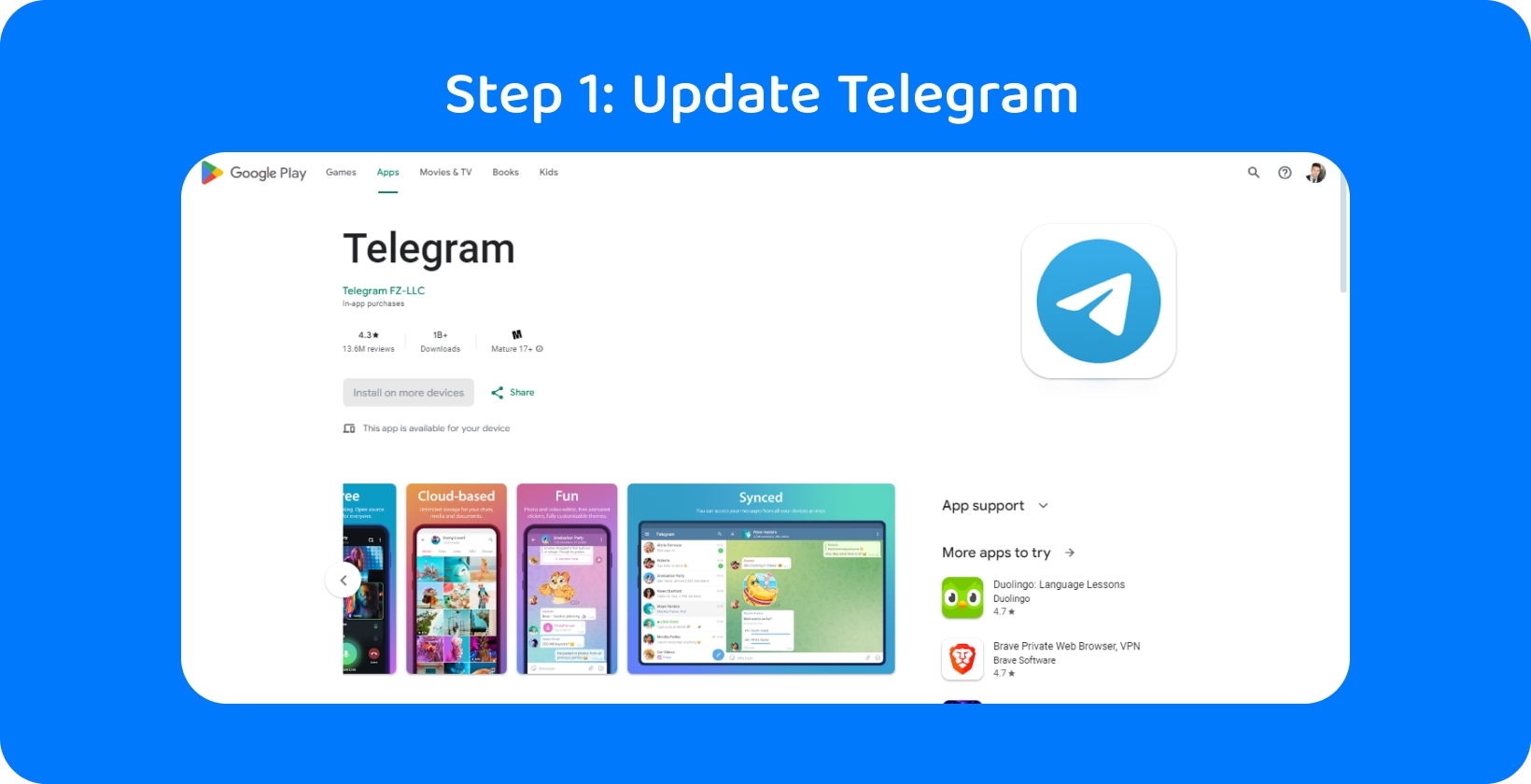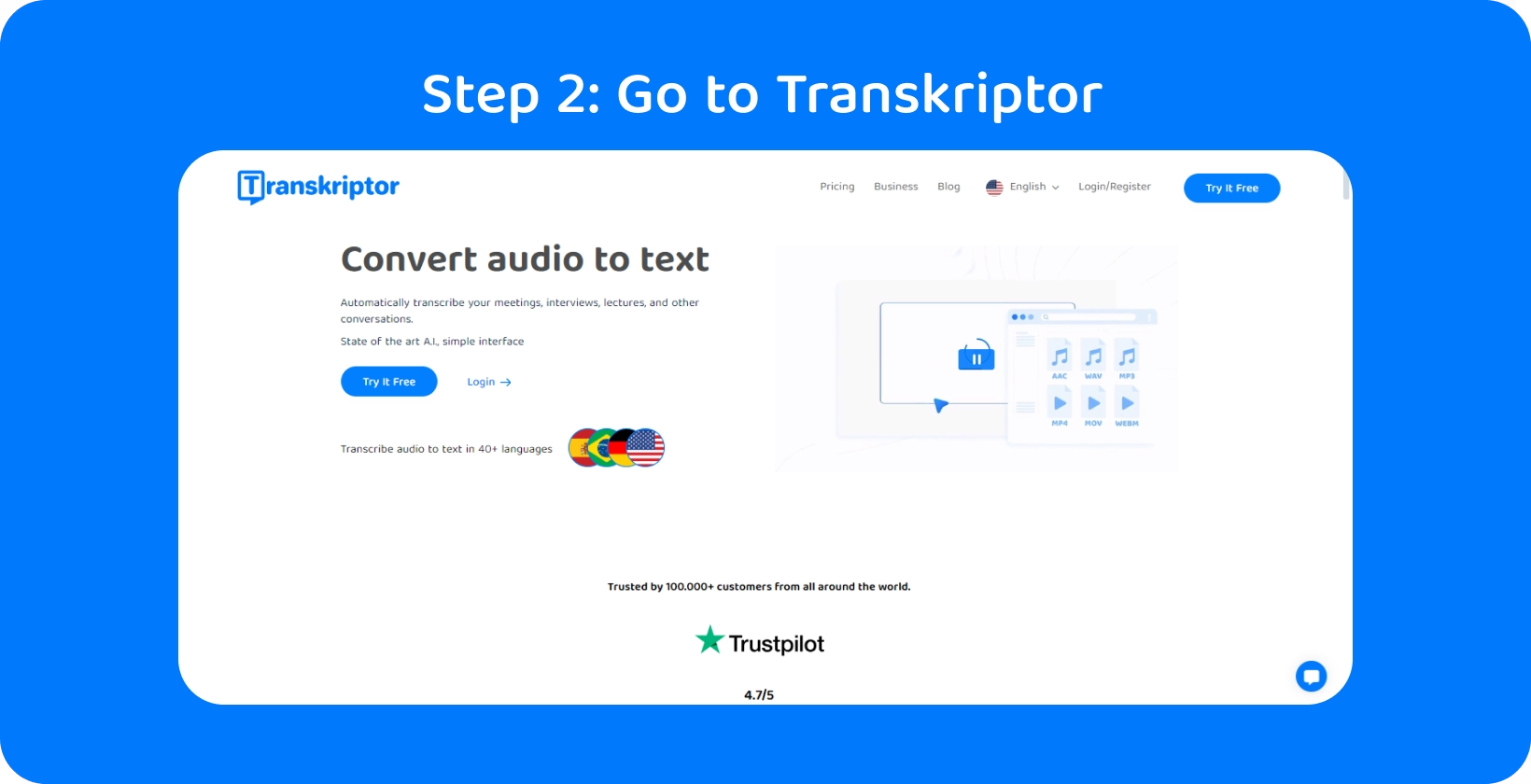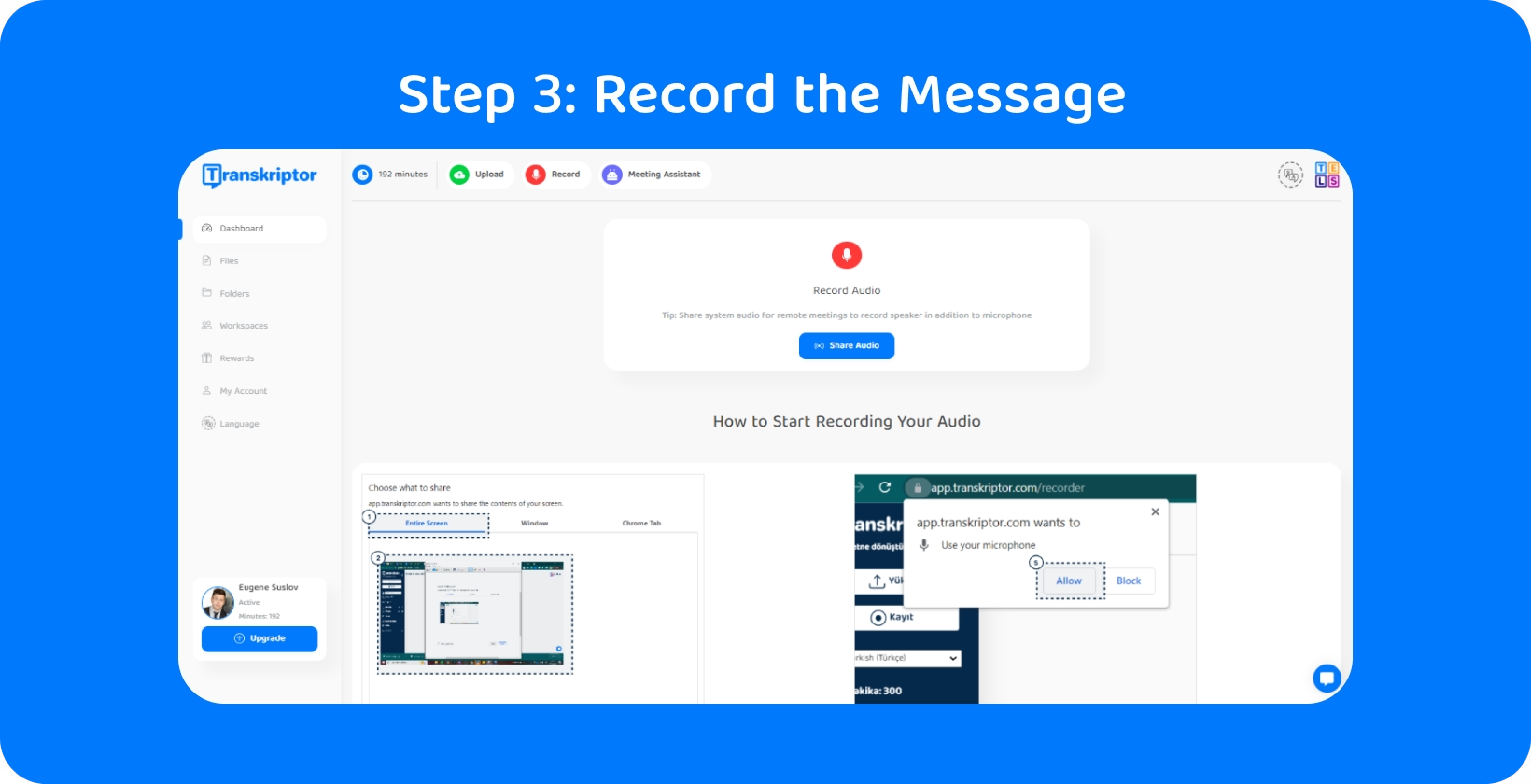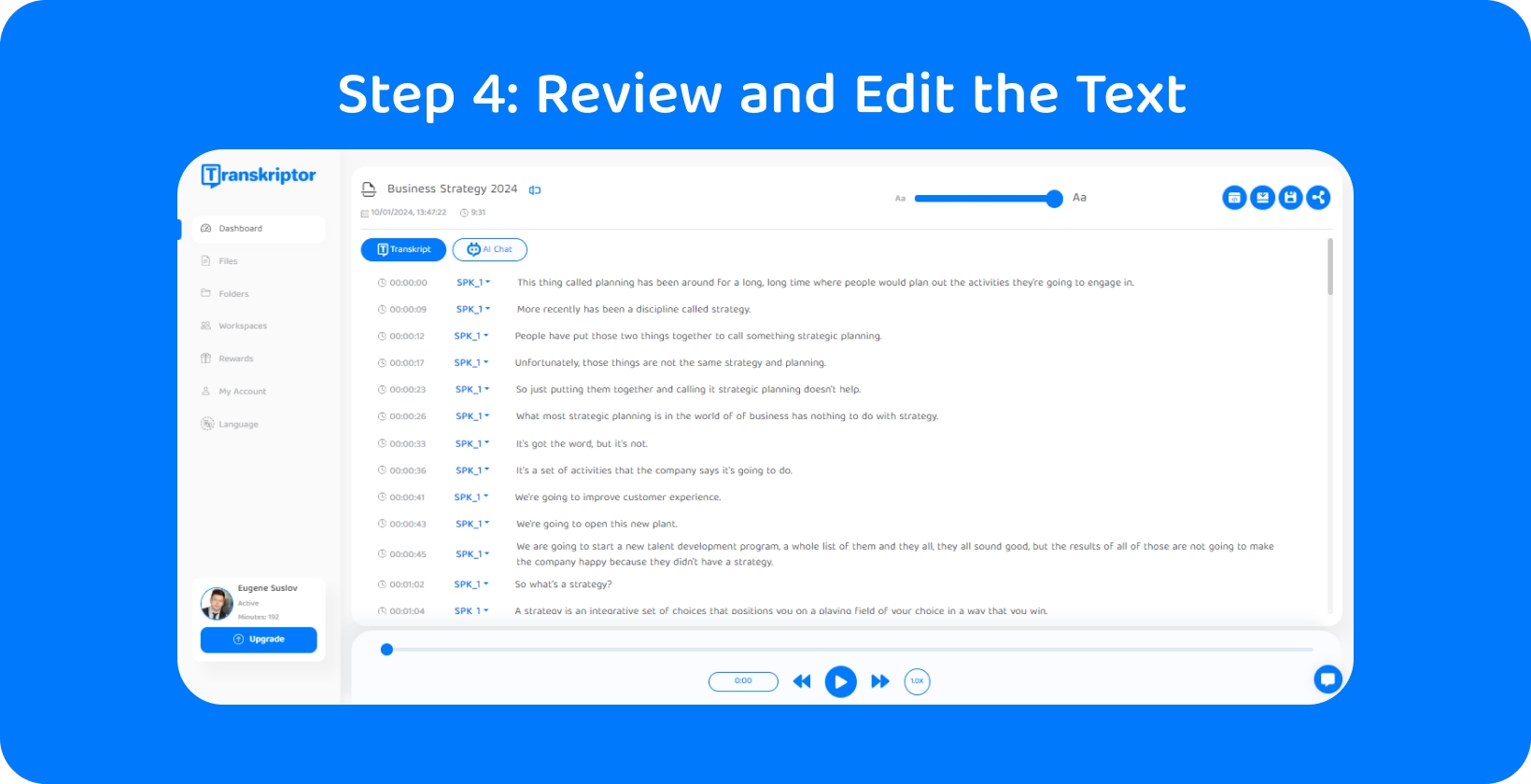Converting voice messages to text in Telegram seems straightforward at first glance, but having clear guidance will make it even easier and more efficient.
The 5 steps to convert voice to text in Telegram.
- Update Telegram: Ensure the Telegram app is updated by checking Google Play or the App Store. Download the latest version to access new features and improvements, enhancing the app’s performance and security.
- Register on Transkriptor: Sign up on the Transkriptor website with an email and password. Navigate to the dashboard to access transcription features for audio or video files, live recordings, or meeting transcriptions. Manage and organize previous transcriptions for easy access.
- Record the Message: Use Transkriptor’s 'Record' feature to capture new voice messages directly on the platform. Speak clearly into the microphone for accurate transcription, then allow Transkriptor to convert the speech into text.
- Review and Edit the Text: Examine the transcribed text for any errors. Utilize Transkriptor’s editing tools to correct mistakes directly within the interface, ensuring the final version accurately represents the original message.
- Copy and Paste Text into Telegram: After editing, copy the corrected text from Transkriptor. Open Telegram, select the appropriate chat, paste the transcribed text into the message field, review for context, and send the message to maintain clear and effective communication.

Step 1: Update Telegram
Users must ensure their application is up-to-date to convert voice to text in Telegram effectively. This step is crucial as the latest version of Telegram often contains new features and improvements that include enhancements to voice messages or user experience updates.
Users should check for updates by navigating to Google Play or the App Store on their device. They should search for Telegram and select it from the search results once there.
An "Update" button will be visible next to the application if an update is available. Users are able to initiate the download and installation of the latest version by tapping this button.
This process ensures they have access to Telegram's most current tools and functionalities. Keeping the app updated improves its performance and secures the data and conversations, as updates often include security patches and bug fixes.

Step 2: Go to Transkriptor
Unfortunately, Telegram lacks a voice-to-text feature. Users looking to convert voice to text in Telegram should start by signing up on the Transkriptor, providing their email, and creating a password for their account.
Next, they are directed to the dashboard, the central hub for accessing Transkriptor's features. The dashboard presents users with three primary options: upload audio or video files for transcription, record audio directly through the platform.
Additionally, the dashboard offers a comprehensive overview of all previously uploaded recordings and files, enabling users to manage and revisit their transcriptions easily. This organized approach not only streamlines the process of converting voice messages to text but also provides a convenient way to keep track of all transcription activities, making it an invaluable tool for users who regularly rely on text versions of audio communications.

Step 3: Record the Message
Users should convert their voice messages to text by utilizing the recording feature after signing up and accessing the Transkriptor dashboard.
They should select the 'Record' option, which enables them to capture audio directly through Transkriptor’s voice-to-text feature. This function is beneficial for creating new voice messages that need transcription.
Users initiate the recording with a simple click and begin speaking into their device's microphone, ensuring their messages are clear and audible for accurate transcription. They stop the process once the recording is complete, and Transkriptor immediately begins converting the spoken words into written text. The advanced speech recognition technology employed by Transkriptor ensures high accuracy, effectively capturing nuances and variations in speech.
The text is readily available for review and editing on the dashboard after the voice transcription is finalized. This allows users to make necessary adjustments to ensure the transcription accurately reflects the recorded message.

Step 4: Review and Edit the Text
Users proceed to review the generated text for accuracy once they have their voice messages transcribed by Transkriptor. The transcription process, while advanced, isn't able to capture every nuance correctly, leading to potential errors in punctuation, spelling, or grammar.
Users should examine the transcribed text closely, identifying any discrepancies or mistakes that have arisen during the conversion process. Transkriptor facilitates this step by allowing users to edit the text directly within its interface, ensuring they are able to make immediate corrections. This editing feature is accessible on the desktop and through the Transkriptor smartphone app, offering flexibility to users working across different devices.
They are able to correct punctuation errors, typos, and any other inaccuracies to ensure the final text accurately represents the original voice message.
Step 5: Copy and Paste Text
Users proceed to the final step of converting their voice messages to text in Telegram following the review and editing phase.
They select the transcribed text within Transkriptor with the corrections made, and the text now accurately reflects the spoken message. They use the copy function to capture the edited content, ensuring every part of the text is included.
Next, users navigate to the Telegram application, identifying the chat where they intend to share the transcribed message. They tap the text input field within the desired chat, a familiar space where messages are usually typed. Here, users engage the paste function instead of typing. This action directly transfers the copied text from Transkriptor into Telegram's messaging interface.
A final review within Telegram should ensure it aligns with the conversation's context and tone with the current text. Users then should send the text to their contact or group chat once satisfied that the message accurately conveys their intended communication.
This process effectively transforms voice messages into written form, enabling users to communicate flexibly and inclusively within Telegram.
Why Convert Voice Messages to Text in Telegram?
Converting voice messages to text in Telegram serves multiple purposes that significantly improve user experience. This process increases accessibility for deaf and hard-of-hearing users or those who prefer reading over listening. It ensures that everyone has equal access to shared information by transforming voice messages into text, regardless of their ability to process audio content.
Moreover, text messages provide clarity when listening to audio is challenging. Reading a message in noisy surroundings or situations where privacy is a concern is often more feasible than playing a voice message. This conversion ensures that the communication remains effective and discreet, regardless of the user's circumstances.
Another critical advantage of converting voice messages to text is the improvement it brings to communication efficiency. Text messages are searchable, making it easier for users to find specific information without the need to listen through several voice messages. This capability is particularly useful for referencing past conversations or locating specific information quickly.
Tips for Better Voice-to-Text Conversion in Telegram
Achieving accurate voice-to-text conversion in Telegram is key to seamless communication, especially when voice messages are a preferred mode of interaction.
However, the quality of voice-to-text conversion will be significantly improved with a few strategic practices to ensure messages are accurately captured and conveyed in text form.
Tip 1: Use a High-Quality Microphone
Users should prioritize using a high-quality microphone for their recordings to achieve better voice-to-text conversion in Telegram. A superior microphone captures clear audio input, significantly enhancing the quality of the voice typing on Telegram.
This clarity is crucial for transcription services like Transkriptor to convert voice to text in Telegram accurately. High-quality microphones are designed to minimize background noise, ensuring that the voice message is audible and free from distracting sounds that interfere with the transcription process.
Using a high-quality microphone improves the accuracy of speech recognition technology, reducing the likelihood of errors in the transcribed text. Clear audio allows these technologies to distinguish words and phrases better, effectively capturing the nuances of speech. This precision is particularly important for maintaining the message's integrity.
Tip 2: Speak Clearly and Slowly
Users must focus on speaking clearly and slowly for optimal voice-to-text conversion in Telegram. Articulating each word precisely ensures that the transcription bot accurately interprets and converts speech into text. Clear articulation reduces the chances of misinterpretations and errors in the transcription and voice typing on Telegram, facilitating a smoother communication process.
Maintaining a moderate pace while speaking is equally important. Rushing through sentences or speaking too quickly will lead to word blending, making it difficult for speech recognition technologies to distinguish individual words and phrases accurately. A slower, deliberate pace helps separate words and allows the transcription service to capture the content of the message better.
Tip 3: Minimize Background Noise
Users should make a concerted effort to minimize background noise when recording their messages to enhance the quality of voice-to-text conversion in Telegram. Recording in a quiet environment is crucial as it reduces background sounds interfering with the voice recognition process. Ambient noise, from traffic sounds to conversations and electronic devices, will distort the audio input, leading to inaccuracies in the transcription.
Users ensure that their voice is the primary focus of the audio input by choosing a calm and quiet setting for recording. This clarity allows the transcription bot to distinguish and accurately convert voice to text in Telegram more effectively. The absence of competing sounds in the background significantly improves the speech recognition technology's ability to process the voice message without errors.
Tip 4: Keep Messages Short
Users are advised to keep their messages short for enhanced voice-to-text conversion in Telegram. Shorter voice messages significantly improve transcription accuracy, making it easier for the transcription bot to process and convert into text. Users reduce the complexity of the speech recognition task by conveying their message succinctly, minimizing the potential for errors in the transcribed text and during voice typing on Telegram.
Concise messages facilitate a more straightforward and efficient transcription process. They allow the speech recognition technology to focus on a smaller set of data at one time, improving the overall conversion quality. This approach ensures that the essential details of the message are captured accurately and streamlines the communication process, making it quicker for both the sender and the recipient.
Tip 5: Review and Edit the Transcription
Users should always take the time to review the transcribed text for errors after utilizing voice-to-text conversion in Telegram. This critical step ensures that the final message accurately reflects the spoken words.
Transcription errors are likely to occur despite advancements in speech recognition technology, ranging from minor typos to misinterpreted words or phrases. Reviewing the text allows users to identify and rectify these inaccuracies, maintaining the integrity of the message.
The editing feature plays a vital role in this process. It empowers users to make necessary corrections to the transcribed text, ensuring the content is accurate and coherent. Users are able to adjust spelling, grammar, punctuation, and even sentence structure if the transcription bot misinterprets the original voice message. This capability is essential for clear and effective communication, as it prevents misunderstandings that arise from incorrect transcriptions.
Users contribute to a more reliable and efficient communication process by reviewing and editing the transcription before sharing it. This practice enhances the quality of the message sent and reinforces the usefulness of voice-to-text conversion in Telegram as a tool for accessible and accurate messaging.
Take the first step towards clearer, more accessible communication by trying the Transkriptor platform today!
Discover Transkriptor: the Go-To Voice to Text Conversion Tool
Transkriptor is an innovative platform tailored to simplify the conversion of spoken language into written text, thereby providing a seamless bridge for users. By signing up on Transkriptor, users are welcomed into a world where their voice messages can quickly turn into accurately transcribed texts. This platform supports a wide range of transcription needs—from audio or video file transcriptions to live recordings and meeting notes.
What sets Transkriptor apart is its combination of a user-friendly interface with powerful editing tools, ensuring that the final text representation is not only error-free but also mirrors the original message with precision. Whether for professional meetings, academic lectures, or personal notes, Transkriptor’s versatility and efficiency make it an indispensable tool for anyone looking to document their thoughts or conversations. Try it for free!

